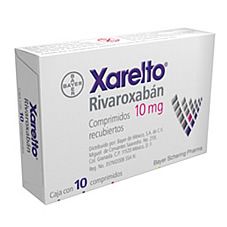Top Class Actions’s website and social media posts use affiliate links. If you make a purchase using such links, we may receive a commission, but it will not result in any additional charges to you. Please review our Affiliate Link Disclosure for more information.

According to the Xarelto lawsuit, William N. Packard, Jr. began taking the medication for atrial fibrillation in January 2012 and six months later, in a desperate attempt to stop Xarelto bleeding complications, doctors attempted to drill a hole directly into the man’s skull to allow the blood to drain with no success. He died five days later.
Like Pradaxa side effects, a blood thinner that acts in a similar fashion and is the subject of litigation, part of the issue with the use of Xarelto (rivaroxaban) is that there is no antidote for bleeding should it occur, unlike the generic warfarin (coumadin). While Johnson & Johnson marketed Xarelto as a superior option compared to warfarin because of its easy dosing and lack of regular testing, the Xarelto lawsuit argues that medical research indicates that all patients should be tested because of differences in body fat percentage, weight and other factors.
The Food and Drug Administration also evidently had doubts about Xarelto bleeding incidents, as clinical reviewers have stated that “rivaroxaban should not be approved unless the manufacturer conducts further studies to support the efficacy and safety of rivaroxaban” and the FDA website notes that “[a]dverse event reports of thrombocytopenia and venous thromboembolic events were identified” in relationship to Xarelto.
It might have helped Packard, the Xarelto lawsuit goes on to note, if the drug makers had included similar information in their warning labels as he would have likely chosen an alternative treatment, but that continues to not be the case even as the Institute for Safe Medication Practices reports that “as with other coagulants, the rate of clinically relevant bleeding in clinical studies was high–15% per year of treatment.”
The Xarelto lawsuit is Nancy Packard v. Janssen Research & Development, LLC, et al., Case No. 14-cv-61448, U.S. District Court for the Southern District of Florida.
In general, Xarelto lawsuits are filed individually by each plaintiff and are not class actions.
Do YOU have a legal claim? Fill out the form on this page now for a free, immediate, and confidential case evaluation. The attorneys who work with Top Class Actions will contact you if you qualify to let you know if an individual lawsuit or class action lawsuit is best for you. Hurry — statutes of limitations may apply.
ATTORNEY ADVERTISING
Top Class Actions is a Proud Member of the American Bar Association
LEGAL INFORMATION IS NOT LEGAL ADVICE
Top Class Actions Legal Statement
©2008 – 2024 Top Class Actions® LLC
Various Trademarks held by their respective owners
This website is not intended for viewing or usage by European Union citizens.
Get Help – It’s Free
Join a Free Xarelto Class Action Lawsuit Investigation
If you or a loved one took Xarelto (rivaroxaban) and suffered injuries such as uncontrollable internal bleeding, gastrointestinal bleeding, hemorrhaging, deep vein thrombosis or pulmonary embolism, you may have a legal claim. See if you qualify by filling out the short form below.
An attorney will contact you if you qualify to discuss the details of your potential case at no charge to you.
Oops! We could not locate your form.












